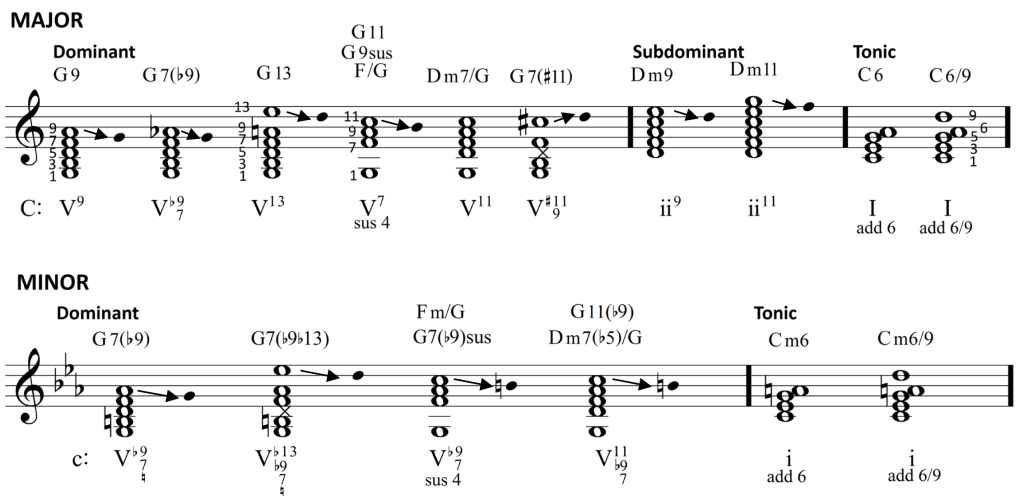30 The Development of 9th, 11th, and 13th Chords
During much of the Common Practice Period (1600-1900), nonharmonic tones (PT, NT, app, sus) appear as momentary 9ths, 11ths, and 13ths. Since the duration of these nonharmonic tones is only a fraction of the chord’s duration, they are considered embellishments rather than actual members of the harmony.
During the nineteenth century, composers increased the length and emphasis of these nonharmonic tones. So instead of a seventh chord, the listener hears a 9th, 11th, or 13th chord for almost the full duration of the harmony. By the end of the nineteenth century, these extensions were fully accepted as members of the chords.
The 9ths, 11ths, and 13ths often occur in the soprano, creating new melodic possibilities. The chords most commonly occur in root position, since the inversion of a five or six note chord may obscure the function of the original chord. In functional harmony, the 9ths, 11ths, and 13ths shadow the seventh of the chord and resolve down by step.
The most frequent usage includes adding a 9th or 13th to a dominant seventh (V7)chord, the 9th or 11th to the subdominant seventh (ii7) chord, and the M9 or a M6 and M9 (6/9) added to the tonic (I) chord. (The 6/9 chord is a triad with an added M6 and M9, and does not include a 7th.) Observe the Arabic number guides next to the tall chords below, indicating the intervallic structure.

Voice Leading
1. Ninth Chords
The 9th as a suspension that becomes a functional part of the dominant ninth chord.
The 9th as an appoggiatura that becomes a functional part of the dominant ninth chord.
The flat 9th as a chromatic neighbor tone that becomes a functional part of the dominant flat ninth chord.
The le passing tone from example 1g becomes the flat 9th of the dominant seventh chord in example 1h. Additionally, the tonic triad is enhanced by the added M6.
2. Thirteenth Chords
The 13th as a suspension and an appoggiatura, either of which becomes a functional part of the dominant thirteenth chord.
In example 2d, the tonic is enhanced by the added M6, the ii7 chord has an added M9, and the V9 chord has an added M13. Note that in the dominant thirteenth chord the 13th replaces the 5th of the chord. In example 2e, the colorful use of the appoggiatura flat 13th (me) becomes part of the G7 chord resolving to a tonic triad.
3. Eleventh Chords
The 11th as part of a 4-3 suspension that becomes a functional part of the dominant eleventh chord.
The suspension resolving into a dominant ninth chord and then becoming a functional part of the dominant eleventh chord.
A ii7 chord with a double appoggiatura becoming integrated into the ii11 chord.
Practice
Transpose the examples above into several major and minor keys. Play at the keyboard.
Examples from the Literature
The examples below show the various stages of integration of 9ths, 11ths, and 13ths into traditional triads and seventh chords.
Dominant Chords
In the Chopin example, the repetition of the nonharmonic B![]() ’s (as NT and PT) make the B
’s (as NT and PT) make the B![]() a functional part of the V9 chord.
a functional part of the V9 chord.
The length and accent of the high A appoggiatura in the Mendelssohn example produces a V9 chord over a C pedal.
The Schumann example has a m9 added to the G7 chord.
Strauss elaborates the dominant seventh with chromatic passing tones leading to an arpeggiated V9 chord.
Here Strauss uses the 9th and ![]() 9th as passing tones:
9th as passing tones:
*![]() 9 spelled enharmonically
9 spelled enharmonically
The Chopin example below introduces the secondary dominant ninth chord and includes an accented neighbor tone ![]() 11.
11.
In the Saint-Saens ii – V – I cadence, the 9th of the Dm9 chord is suspended to become the 13th of the G13 chord.
Inversions of the dominant ninth chord with typical accompaniment patterns (such as do – so, – re – so,) are found in the waltz and march. In the Strauss example below, note the similarity between the Go7/B![]() (m.2) and E
(m.2) and E![]() 9/B
9/B![]() (m.6) chords. The final tonic chord has an added sixth.
(m.6) chords. The final tonic chord has an added sixth.
Subdominant Chords
The Mendelssohn example shows the subdominant ii9 implied by the long G appoggiatura and dominant V9 chord by the repeated C notes.
In the Grieg example, the Em9 resolves to the dominant A11. The melodic motive in measure 3 includes both the 9th and 11th of the dominant chord.
A beautiful use of a subdominant ii11 chord:
Tonic Chords
The examples below show the Impressionist technique of adding a 6th and/or 9th to the tonic chord. (See chapter on 20th Century Compositional Techniques.)
The continuous use of the M6 with the G major triad creates a Iadd6.
The continuous use of the M6 and M9 with the E major triad creates a Iadd6/9.
The dominant 9th leading to the tonic triad with the added M6, then to a tonic M9, and then back to the added M6. In the Amaj9 chord, both the 7th and 9th resolve down by step.
Practice